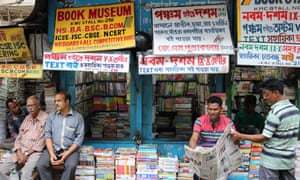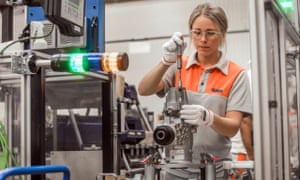There is a cricket match on. Not high-profile but still an international. Like all internationals, it is being televised. The broadcast director spots a player from Team A tampering with the ball. He shares the footage with the match referee, who brushes the matter under the carpet and hands out a slap on the wrist. The director has done his job; it is up to the match referee to determine the degree of offence.
It is not the end of the story, though. The manager of Team A, the away team in this case, confronts the channel. "You are only after our guys," he says. The footage is not aired on TV but a token punishment has been handed out. A commentator on the broadcast, a former player from Team B, the host team in this case, gets wind of it, and puts pressure on the broadcaster, through his board, for the footage to be aired, because the punishments handed out tend to be more severe when the evidence is made public, once the righteousness kicks in. The TV channel doesn't know what to do. It can't really afford to antagonise either board because it is in business with both. So to get the local board off his back, the director tells the home board that if he airs the footage he is being urged to, he will have to be equally vigilant with the home team and air any footage that the cameramen come up with. The threat works.
That, ladies and gentlemen, is a short story about ball-tampering, but it tells you more than any other yarn can.
On paper the umpires run the game, but they can only act if they have video evidence, because the ICC's code-of-conduct charges must be able to stick in a court of law. And remember what happened the last time an umpire acted without video evidence, at The Oval in 2006?
Which brings us to commentators. Many of them - not all - still consider themselves part of the teams they once represented. They fight their team's PR battles in the commentary box, and some often go beyond, in trying to make sure "their boys" are on the right side of calls of ball-tampering and player behaviour.
There are exceptions - like the one who asked the broadcast director in a match to keep an eye on the team that commentator once played for because he could sense something dodgy happening. It resulted in the discovery of a new tampering technique and a hefty fine. Needless to say, the "boys" don't like the commentator now, but they haven't yet got to the level of entitlement where it drives them enough to get him fired.
The way teams react makes it clear how commonplace tampering is. The manager of the guilty team says his side is being targeted; he knows other teams are guilty just as often. The other board has no reason to back off, other than, well, its team also does it. And whenever anything happens, the ICC, the commentators, the teams and their boards, all run to the broadcasters.
Since that Oval match, all the ball-tampering incidents that have officially been termed as such have relied on broadcasters. On all occasions, it is away players who have been caught tampering: Faf du Plessis in the UAE and in Australia, Vernon Philander in Sri Lanka, Shahid Afridi in Australia, and Dasun Shanaka in India. Aspersions were cast against Stuart Broad and James Anderson in South Africa, where too now the Cape Town three have been caught.
Neutral broadcasts - during ICC events - have not caught a single player tampering with the ball (though there was a match in the 2013 Champions Trophy where the umpires quietly changed the ball without imposing penalty runs, to avoid the morality furore that accompanies the laying of a ball-tampering charge, and also because the broadcast didn't have footage to back them).
"Would there have been footage against a home player? Would the broadcaster have even gone looking? More importantly, should cricket be comfortable with broadcasters wielding so much influence practically unwatched and unchecked?"
The Cape Town scandal is a perfect example of the role the broadcaster needs to play for a ball-tampering offence to not just come to light but for the charge to stick. Various broadcast directors have told ESPNcricinfo they don't usually follow the ball as closely as was done here. For example, in the normal course, they follow the ball into the keeper's gloves, through to slip, and then cut away to some other action. One of them says it is mostly so they can turn a blind eye to some of the tampering, without which, he believes reverse swing is not possible. He means that the use of lozenge-laden spit, and fake shining - when the thumb hidden between the ball and the thigh goes to work - is actually often overlooked. Call it the thieves' code but this much has been acceptable and well known.
Also, broadcasters don't usually want to play dirty and expose only the visiting side, given both teams might equally be doing things that are considered, among cricketers, as Derek Pringle once wrote, "little more than mischief". No director wants to live with that guilt until he is asked to look for something - in which case, the moral responsibility lies with someone else.
In Cape Town last month, though, the broadcasters were on Australia all along. David Warner's heavily taped hand came under the scanner first. Warner knew it too. When visuals first emerged, the tape on his hand was unmarked. The next day he had his wife's name written on it - a possible wink to the broadcasters that he knew what they were up to. Was the focus on Warner a possible reason for ball-handling duties being transferred to Cameron Bancroft?
The actual footage that led to the nabbing of Bancroft had a shot from the midwicket camera between overs. Not only is it rare for cameras to be following the ball between overs, but also for between-overs footage to be recorded on the EVS platform. EVS is a Belgian company that manufactures live outdoor broadcast digital production systems. For something to be replayed, the EVS system has to record it first. Between-overs footage from midwicket cameras is not often recorded. When Bancroft shoved the sandpaper into his pants, however, he was at short extra cover, which happened to be the perfect position for the Ultra Motion camera - usually placed at reverse slip - to catch him in the act. That said, once the broadcast wants to go after you, there is no fielding position that is safer than others.
Fanie de Villiers, the former South Africa cricketer, now a commentator, has since said to RSN Breakfast, a radio show, that they, the commentators, had asked the cameramen to look for tampering. The version coming from the Australian media is that the South Africa players had made a request through the commentators. Alvin Naicker, head of production at Supersport, was soon quoted by Supersport as saying they spotted something first and then went looking closely, not the other way around.
"If we go looking for it," says another director familiar with at least two ball-tampering incidents in the past, "over a three- or four-Test series, we can catch any team. Everybody does it. Every time there is some reverse, there is something behind it." Unless, of course, it is one of those replaced balls that begin to "go" immediately, like for Dale Steyn in Nagpur in 2010, or for Mitchell Starc in Durban in this series.
South Africa are no saints when it comes to ball-tampering, as their record will show, but they have never been caught at home. The last time they were caught, in Australia, they were incensed. Not because they didn't do it - it was on tape - but presumably because it was such a minor and acceptable act that they must have felt the thieves' code had been broken. Footage that was either not seen during the broadcast or was too insignificant to have been noticed, had conveniently made its way to - surprise, surprise - a news channel. The ICC's hands were now tied. It had to act. It did. Faf du Plessis and South Africa were furious.
There has been an unspoken rule among broadcast directors to not have cameras follow the ball when it is not in play, so a blind eye can be turned to "routine" tampering, without which reverse swing is not possible
Naicker obviously rubbished any suggestions his channel might have acted on instructions or as a response to what happened in Australia. "We don't want it to seem like we are going after the Australian team," he was quoted as saying by Supersport's website. "If that was a South African, we would have broadcast the footage for sure. We have a responsibility to entertain, but just like journalists, we have a moral obligation to provide unbiased editorial."
The question, though, is: would there have been footage against a home player in the first place? Would they have even gone looking? More importantly, should cricket be comfortable with broadcasters wielding so much influence practically unwatched and unchecked?
As cricket continues to embrace technology, host broadcasters have assumed huge significance. ESPNcricinfo knows of a case where a broadcast didn't air footage of, or alert match officials to, a home player tampering with the ball; and it is a fact that they hardly ever go looking for tampering with home players. There have been various other instances where the umpires have seen something but can't find footage to back their claims.
The ICC has practically outsourced decision-making to the broadcasters, and it is not restricted to ball-tampering. ESPNcricinfo has learnt that on day four of the Bangalore Test between India and Australia last year, India's coaching staff asked a commentator to ask the broadcaster to keep an eye on Australia because they had suspected dressing-room assistance on DRS. It just so happened that that was the day Steve Smith was caughtsoliciting such assistance , but what resort do India have if they suspect something similar on an away tour? Malcolm Conn, a former cricket writer with News Corporation, and now Cricket Australia communications manager, might well have been referring to these cases when he pointed to the "hypocrisy of home advantage" in lashing out at yet another tweet by British media enjoying the Australians' suffering. Home advantage is not restricted to pitches and conditions anymore. If it wants to be, the broadcaster can well and truly be the 12th man for the home team, and the ICC can do nothing about it.
The ICC, in fact, trusts broadcasters more than it does its own umpires, who are not allowed to stand in matches in which their country is playing. The broadcaster, on the other hand pays for, controls, and mans the technology required for all the decision- making. Projected paths used for DRS lbw calls are off limits for any independent scrutiny because the technology is "proprietary". And yet, even if the broadcasters don't like it, they are forced to pay for Hawk-Eye because the ICC has made it mandatory for the DRS.
Broadcasters, like everyone else, are open to biases. Biases of nationality, biases of what is best for business (home teams losing or their players getting caught cheating certainly aren't). The biases weren't born with the DRS either. If you remember Jonty Rhodes' low catch to dismiss Sachin Tendulkar in the washed-out 1996-97 tri-series final in Durban, you will remember Rahul Dravid fell to a similar low catch but replays of that were not shown. When Kapil Dev mankaded Peter Kirsten, Kepler Wessels hit Kapil on the shin with his bat - visuals we have never seen. Google "Matthew Wade Virat Kohli sendoff", and you will find many videos of Wade arguing with Kohli for sneaking in a bye when Wade was hit by the ball - incidentally the very kind of moralising that resulted in such schadenfreude at Australia's recent fall - but you will not be able to find footage of the sendoff that Kohli gave later in the same match.
Yet it remains next to impossible for a broadcaster to cheat - be it "losing" a key visual, providing a wrong replay to determine a no-ball, or playing around with other evidence - because it is just impossible for something dodgy to have happened and for it to stay in the production control room. These things travel, unless the manipulation is systemic or institutionalised. There is no evidence of this having happened yet, but like with other conflicts of interest, it is the possibility of it that should make people uncomfortable.
"Broadcasters, it needs to be stressed, don't like to be in a position to influence results, no matter what they do to influence public opinion with their commentary and other output"
Broadcasters, it needs to be stressed, don't like to be in a position to influence results, no matter what they do to influence public opinion with their commentary and other output. What are they to say to the home captain if he wants extra scrutiny on the opposition? They are in the entertainment business, and they would rather they didn't have to carry the additional burden of decision-making in these contexts. In fact, they hate it when they are told to turn down the volume of the stump mics because the players are abusive. They don't pay astronomical sums to be told what they can or cannot show. They want the ICC to control the players instead of controlling the broadcast, which is enhanced by the observations and quips of a wicketkeeper such as MS Dhoni. They want the ICC to take control of decision-making technology so that they, the broadcasters, are not seen as all too powerful.
They are not happy that the third umpire doesn't sit with them and take charge of what he wants, but for that the ICC has a valid explanation. The third umpire sits alone because any conversation he has with others is liable to directly or indirectly influence his decision-making.
While the ICC has made strides towards training its third umpires in the use of technology, there remain inconsistencies. "One match referee tells me I must give the third umpire only what he asks for," a director says, "while another says I must give him everything that can help him arrive at the correct decision. As an organisation, ICC seems happy with not taking absolute control and the accountability that comes with it."
Recently in a PSL match, Karachi Kings' celebrations were halted when it was discovered the last ball of the match was a no-ball. No umpire had suspected one in this case but the broadcasters alerted them. This no-ball resulted in a Super Over, which Karachi lost. What are the odds of this happening to the home team in a bitterly fought contest between Australia and South Africa?
It is not that the ICC is not aware or not uncomfortable. It has been discussed in the ICC that only away players get caught tampering with the ball. Like with most things ICC, the governing body can't do much more. It cannot take any action without video evidence, nor can it look away when a broadcaster puts evidence out there. When umpires come back to the ICC with suspicions of ball-tampering, they review the available footage and find nothing. Even at The Oval in 2006, Pakistan accepted the decision at first, and hit back at the umpires when they were sure there was no footage to implicate them, an ICC source has revealed. It is not practical for the ICC to ask the broadcaster for additional footage that might help implicate a home player, because of the blowback that will immediately ensue. And yet when footage appears of du Plessis going to his lozenge to shine the ball, the ICC has to act, even though a blind eye is turned to this kind of thing most times.
The ICC is also aware its trust in broadcasters for the DRS and third umpires is blind. The only direct solution is to pay for all the technology and also have a few cameras at every international match to monitor ball-tampering. This is not cost-effective, and it has not gone beyond ICC board meetings. Ultimately if the ICC does pay for all the technology, the money has to come from the member boards - and, like in the matter of the Associates, we all know what the decision has been there, and is likely to be in future. The other solution to this was to accept ball-tampering as an offence of the nature of over-appealing or showing dissent, but that ship sailed long ago, as was obvious in this most recent episode from the sadistic sanctimony of various former captains.
So as usual, the ICC is likely to look only for indirect solutions when it undertakes a review of its code of conduct, and ball-tampering in particular. If the indications are anything to go by, ball-tampering will become a more grave, more clearly defined offence. The "spirit of cricket" will be defined more clearly. It will be made clearer that the onus is on captains, and possibly boards, to play in the spirit. This is going to increase the pressure on visiting captains even more. This review will be considered successful only if the ICC can somehow find a way to break the home advantage that comes with broadcasters.



